|
FLY FISHING FLIES AND PRESENTATION
Presentation is critical when it comes to fly fishing. The flies you select are very important to whether you catch fish or not. Whether you use a dry fly, a wet fly or terrestrial you must have good technique. You must use the correct size and color and put it where the fish expect to see it when you present a fly in order to catch fish.
Fish know when the hatch is occurring, and exactly what the fly should look like. These are important fly fishing for trout tips. If your presentation is not correct they will simply pass. It can be frustrating when you think you know what they are eating and you put it in front of them just so they can take a close look at your fly and turn away. The reasons for the denial can be many things. One reason could be that your fly is too big or small. They are looking for something that looks exactly like everything else that is floating by them. If your fly is bigger, it doesn’t make it more tempting to the fish. It makes them say to themselves, “something doesn’t look right” and they let yours drift by.
More than likely the problem may be your presentation. If you are using a dry fly it could be that your fly is not in front of your fly line so it is getting dragged and is moving faster than what is on the surface. It may even be getting pulled closer to you so it will not be traveling in a straight line like it should be. You need to continually be mending your line to keep the fly downstream from your fly line, which will reduce the drag. To mend your line you want to swing the fly line from downstream of the fly to upstream of the fly using a roll cast. You must be careful not to disturb the leader and the last little bit of fly line that is floating on the water. You are attempting to put the fly line upstream of the fly so the fly will float naturally, instead of being dragged.
Lastly it may be your leader or tippet. The clearer and slower the water the longer your leader and tippet should be to allow for a better presentation. But it doesn’t stop there. It could be the way your fly is tied on to the leader. Maybe you have some curls in your line just above the hook that is causing it to look funny to the fish. Seems like a petty item, but the fish really are very smart and they will not strike if something doesn’t look right.
It could also be that it is not at the same height as where the fish are looking. Having the proper weight is almost more important than having the right nymph. The presentation of the fly needs to be into their feeding zone. If you see the fish close to the surface then maybe you don’t need any weight. If you don’t see them at the surface you may experiment with different weights until you find the one that is working.
When you combine all the different sizes and all the different types of flies together you would have thousands and thousands of flies to choose from. So how do you know what fly to use? Here is where your local Fly Shop becomes your best friend. The best place to get advice of what type of fly to use is the people who actually fish that water. Chances are your local Fly Shop owner or employee fly fishes way more than the average person so they have a good idea what to use. Also, these same people are talking fly-fishing all day long with other experienced anglers. These people have the knowledge you need to be successful at fly-fishing. If you know what flies you want to use and want to save some money check out this website.
You can go online and look at many of the discount fly shops and other stores that sell flies to see what they look like, but that information is not as valuable as going to your local Fly Shop. Get local advice from a local professional first. Wait until you know what works in your area before purchasing on-line. On-line store are a great source for purchasing flies once you have the knowledge of which to use.
|
Best Selling Waders at Amazon
Product Features 3.5-mm neoprene
Hi-back upper design
Bib-style neoprene suspenders with hook-and-loop adjustment
Fleece-lined hand warmer chest pocket
Reinforced neoprene knee pads
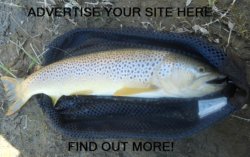
Recommended Links
Sign up for Fish On News Letter
Receive regular newsletters about fly-fishing. Featuring great specials from our affiliate sponsors, new fish photos, tactics, product reviews and other fly-fishing articles. Fill out the form below to subscribe. Fish On!
 |
| Search Cabelas.com |
I had 2 fishing trips in a row that I caught 18 fish. Read my fish story or write your own story.
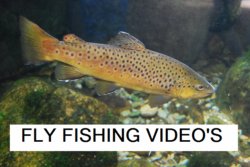
ABOUT ME. I am an average family man who loves to fly fish and still balance my family, career and other interests. I know I am not the only person like that. Click my picture below to find out more about me.
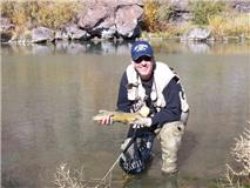
STREAM FISHING TIP. Water levels are very important. So any sudden increase or decrease in the water levels can really change fishing. Be sure to check the most recent river flows for the river you want to fish to see the recent levels. Click on below picture for stream flows.
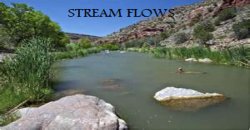
Fishing Etiquette is important. When a fly-fisherman is fishing an area you need to be respectful and not crowd the other anglers. Most fly fisherman will work an area of the river up and down from the spot they are currently at. You should allow them about 150’ in either direction as their own space.





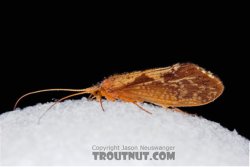 Your fly may be the wrong color. There is a big difference between brown and tan, or tan and cream. Make sure you match the color as closely as possible other wise they will just let your imitation drift by.
Your fly may be the wrong color. There is a big difference between brown and tan, or tan and cream. Make sure you match the color as closely as possible other wise they will just let your imitation drift by.
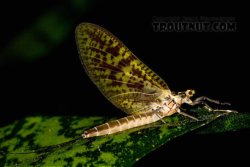 It may be that your fly got a little to wet and it is not on top of the water like it should be. Make a few false casts to dry the fly or put some floatant on the fly. Both of these will make the fly float better and not sink below the water surface.
It may be that your fly got a little to wet and it is not on top of the water like it should be. Make a few false casts to dry the fly or put some floatant on the fly. Both of these will make the fly float better and not sink below the water surface.
 If you are using a nymph the problem could be that the fly line is in front of the fly pulling the fly at a faster rate than everything else in the water. Just like a dry fly you will need to continue to mend your fly line to keep the fly downstream.
If you are using a nymph the problem could be that the fly line is in front of the fly pulling the fly at a faster rate than everything else in the water. Just like a dry fly you will need to continue to mend your fly line to keep the fly downstream. 
